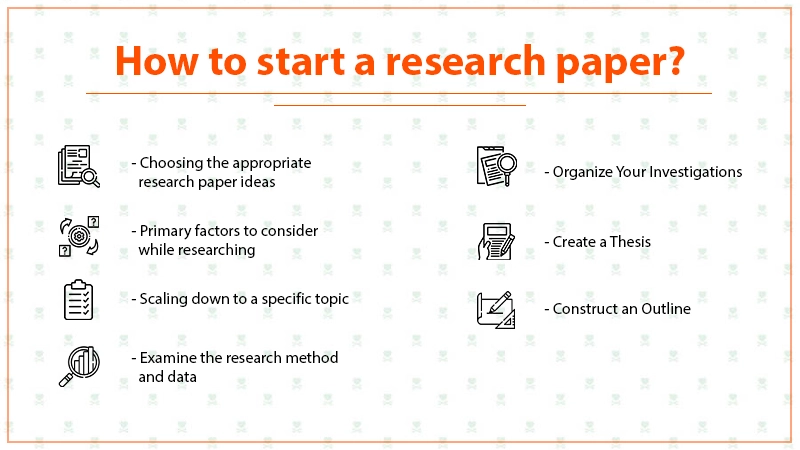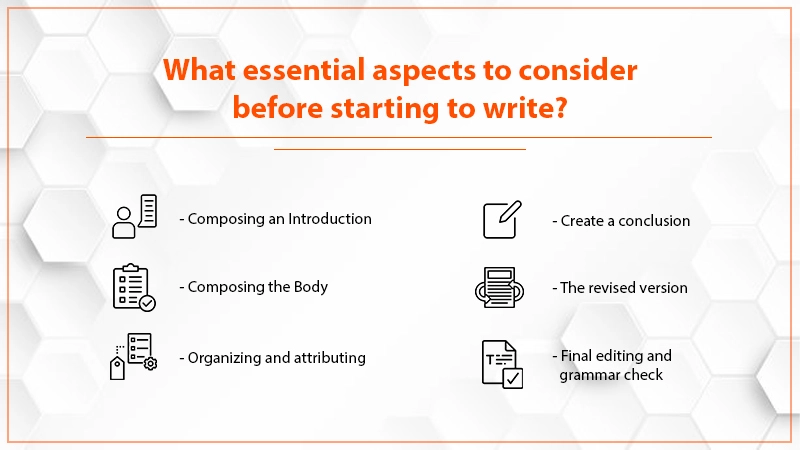Writing research papers is not a natural skill for the majority of us. The conventional research paper follows a highly regulated rhetorical structure. Understanding the rules—some explicit, others implicit—helps tremendously. TO be specific, when it comes to drafting a work that will be approved for publication in a peer-reviewed journal. In consideration of this, we have described, “how to write a research paper” in this article. We’ve crammed a lot of information so that you would get a thorough knowledge of how to write a good research paper.
What is a research paper?
A research paper is an academic piece of writing that is based on the author’s original study and analysis of a specific subject, as well as the author’s interpretation of the research results. At times, writing a research paper may be daunting. Students, particularly those unfamiliar with the rigors of academia, often express anxiety about the procedure, particularly since the paper is frequently given a significant portion of the final mark by a diligent professor.
What distinguishes a research paper from a research proposal and prospectus?
Although the writing process is similar, a research paper seems distinct from a research proposal (also referred to as a prospectus). The purpose of research papers is to show a student’s academic command of a topic. A proposal is a persuasive document designed to persuade readers of the importance of a research topic. Consider the proposal to be the pitch and the paper to be the final result.
A prospectus serves as a draft version for a research project written to persuade a reader. It related to a study to conduct that would provide useful findings.
How to start a research paper?
Always go for a research paper topic that excites the readers and stimulates their curiosity. Your attitude toward the subject dictates how much passion you devote to your study while writing a research paper. Prior to doing the extensive study, get instructor permission for your subject concept and thesis. Additionally, it will assist in saving time and effort.
If you are unsure of the expectations for completing an assignment or project, thoroughly read your assignment sheet or consult your instructor. Make sure you choose an impactful topic that makes the readers curious to know about the information. Avoid technical, educated, or specialist topics. Avoid topics with a relatively limited variety of source resources. Be responsible and committed to the work you write – this is the primary factor in achieving a good grade.
1. Choosing the appropriate research paper ideas
It is critical for pupils to study and write about a subject they are passionate about and are knowledgeable about. Students that are committed and engaged in the topic pay close attention to detail in order to ensure that their work is as good as possible. To accomplish this objective, you must meet the criteria of each article part, including research questions, methodology, analysis, and discussion. Surf the web for inspiration on a variety of research paper themes.
2. Primary factors to consider while researching
Making your paper stand out begins with preliminary research. Go through sample research papers and example research papers to determine what is currently available. This helps to consider a future framework, thesis, or hypothesis. Inquire about previous efforts to address this specific problem. Are there any unexplored avenues that the student should illuminate? Indeed, one may distinguish work by ensuring that some fresh or original idea is addressed, regardless of how little. This not only makes the research article publishable or presentable in academic settings but also ensures that it receives a good mark from the professor who assesses it.
3. Scaling down to a specific topic
After you’ve combed through the required quantity of information, data, and literature on your chosen subject, it’s time to focus your study. It is not suitable if the selected subject is very wide, since there may be many significant facets to this subject. It is not a good idea to include them all in a single research paper since this will result in a work that is unclear or general.
Follow the unique route that piqued your attention and will both occupy a niche and add value to the subject’s discussion. At this point, you should explain why your research is necessary and discuss the importance of your findings.
4. Examine the research method and data
Although this essay will concentrate on the structure and drafting of a research paper, the research process is a critical initial step. Numerous benefits will accrue as a result of your research:
- Comprehension of your topic
- Generating ideas for your essay
- Composing a thesis assertion
- Speaking authoritatively about your subject
Collect and begin examining resource materials. The following are some excellent sources of information:
- Scholar on Google
- Encyclopedias, almanacs, and databases available online
- Periodicals and books
- Newspapers
- Publications, guides, and reports produced by the government
Take notes as you read and analyze the facts you find. Organize your reference sources so that you can cite them and create a bibliography afterward. The Purdue Online Writing Lab (OWL) and other university writing lab websites are great tools for determining what information you will need to gather in order to correctly cite sources.
5. Organize Your Investigations
Now that you’ve gathered all of this data, what are you going to do with it? Step four is all about organization. As with research, individuals have varying interests in this area. Additionally, it may be contingent upon your assignment. A bibliography (meaning “book writing“) is beneficial for organizing your research. Reason – it contains a list of the books, journals, and other sources you utilized.
Consider how you’d want to arrange your research. You may find it beneficial to bookmark resources in your web browser. Else, create a digital bibliography that enables you to connect to the materials you discover. You may choose a written list of your materials. You may want to jot down everything pertinent to your assignment on note cards or sticky notes. Then, arrange your research paper on a table or the floor.
6. Create a Thesis
Determine what the project requires. Select a subject that matches the task, and conduct and arrange your research. Now, you’re ready to express your own viewpoint, argument, or statement. Even if you are not making an argument for or against anything, your paper needs a thesis statement. A thesis statement is a brief statement that you — as researcher and author — make to the readers of your work describing or proving what you are attempting to explain or prove.
When drafting a thesis, a good place to start is with a one-sentence response to the question, “What is the subject of your paper?”
What are the necessary considerations while writing a thesis?
Additionally, it is critical not to be overly ambiguous. Make no apologies about making a powerful message. If you examine the samples above, you will see that each one makes a distinct argument regarding the subject. Another important aspect of writing a good thesis statement is ensuring that your argument is debatable. That is not to say it is contentious or especially opinionated, but it does imply the possibility of disagreement.
7. Construct an Outline
As with a bibliography, the manner in which you construct your outline will vary according to your project. If your instructor has requested that you submit an outline, be careful to create one that adheres to the example, guidelines, or criteria provided. Even if you are not obliged to create an outline, it may be a beneficial tool while you construct your research paper.
Importance of research paper outlines
Outlines are essentially just a way of organizing your work. Avoid becoming overly formulaic, although following patterns and guidelines may be beneficial. You may have written three- or five-paragraph essays in high school, and it is OK to use similar patterns for a college research paper; however, ensure that the structure you select makes sense for your work.
If your thesis contains just two major points, three or five major parts may not be necessary for your research report. If the assignment requires you to introduce a subject, describe several viewpoints on the subject, and then select and explain your own viewpoint, your paper will almost certainly need three major parts, one for each of those goals.
1. Details and factors to consider while creating research paper structure
Your research report should convey a narrative about how you conducted your research, what you discovered, and how your findings improve your area of study. It is critical to organize your research work in such a way that editors and readers can quickly locate pertinent material. The IMRaD format is the most often used framework for research articles. Introduction, Methods, Results, and Discussion are abbreviations for IMRaD. Journals may also need an abstract, keywords, acknowledgments, and references. This style enables scientists to present their findings in an orderly manner. Writers often find it simpler to reorder the IMRaD parts. Nevertheless, the final paper should be organized in the following IMRaD format:
2. Order of Manuscript Preparation
As stated before, the majority of research papers adhere to the IMRAD format. Nevertheless, it is often simpler to write each part in a different sequence than the final paper’s. The authors suggest that you first arrange the data and then write the parts in the following order:
- Decide how your data should be displayed in figures and tables. You may illustrate it using pictures, tables, or just explain it in words.
- It is critical that your techniques be reproducible by anybody
- Results: In this section, you will detail the outcomes of your tests. You make no mention of them here.
- This part needs study, deliberation, and in-depth knowledge of the literature. You must explain your findings without repeating the section on outcomes.
- This part may be included as a subheading or as the last paragraph of the discussion. It should explain how your findings improve the field.
- After considering your findings in the context of the literature, you may compose your introduction.
- This is a synopsis of your paper. Provide a succinct overview of the issue and your efforts to resolve it. Following that, summarize your major results.
- As said before, the title should be succinct and informative. Ascertain that it is logical.
- Keywords: These are used in the indexing process. Keywords must be precise. Frequently, you are not permitted to utilize terms found in the journal’s title. Use abbreviations sparingly and just those that are well-established.
- This part is to express gratitude to anybody who assisted with the study but did not qualify as an author.
3. What to take care of while creating an outline?
While creating an outline, consider what you are attempting to explain or convey in your research paper. The structure of research paper writing will enable you to do it in a clear, structured manner. While it is customary to have an introduction and conclusion, the topic of your essay will dictate what goes between.
The outlining stage of developing your argument is an excellent opportunity to consider which types of reasoning to avoid. If you are unfamiliar with logical fallacies, spend some time reviewing the most prevalent ones; your grade may rely on it!
What essential aspects to consider before starting to write?
Avoid becoming a perfectionist while you write. Make no attempt to discover the ideal words, to use the correct syntax, or to create the perfect title. While editing, there is still time to polish your study paper. At the moment, all you need to do is write. If you quote anything verbatim, you must credit the source. Utilize quotation marks and indicate the quote’s source. Additionally, a Works Cited or References page will need to provide additional information about the quotation. If you paraphrase, that is, utilize someone else’s words but not their exact words, it is still necessary to provide credit. You do not need quote marks here, but it is critical to acknowledge the source of the concept.
If something is a widely recognized fact, you are not required to identify the source of the concept. Bill Gates, for example, is a multibillionaire who created Microsoft. That is a well-accepted truth; it is mentioned in many reliable sources. However, suppose your research writing paper includes what makes Bill Gates’ riches, popularity, and success. Then, you’ll need to credit and reference particular statements and data.
1. Composing an Introduction
You will need to include the following in the introduction:
- Provide important background or contextual information
- When required, define words or ideas
- Describe the paper’s topic and your particular objective
- Expose your organizational strategy
2. Composing the Body
Utilize your overview and prospectus as guiding principles.
- Construct your essay around the ideas you want to convey (i.e., do not let your sources arrange your essay).
- Ensure that your sources are included in your debate.
- Rather than just reporting published material, summarize, analyze, explain, and assess it.
- Ascend and descend the “ladder of abstraction” from generalization to various degrees of detail and then back to the generality.
3. Organizing and attributing
Read and edit to ensure that your thoughts are well-organized and consistent with your thesis statement. Each paragraph should focus on a single subject drawn from the thesis statement. If any paragraph does not, delete it or modify your argument as necessary. Verify that you have correctly quoted and paraphrased, as well as properly acknowledged your sources. Research papers writing services always recommend these steps to ensure the creation of an impactful research paper.
4. Create a conclusion
The research paper’s conclusion is intended to assist the reader in exiting the article’s argument by providing a feeling of closure.
Follow the paper’s progression, stressing how everything comes together to support your thesis statement. Provide a feeling of closure to the article by ensuring that the reader knows how you resolved the problems mentioned in the beginning.
Additionally, you might explore the argument’s broader implications, explain what the article offers future students of the subject, and propose any issues that the paper’s argument raises but cannot or does not attempt to address.
You should refrain from:
- Contribute fresh arguments or critical information
- Take up any more space that is not absolutely required
- Begin with standard words that indicate the conclusion of your document (e.g., “In conclusion”).
5. The revised version
When it comes to the second draft, there are four primary concerns.
Verify that your vision for the paper matches the original draft and, more crucially, that the paper continues to address the assignment.
Identify any assumptions that may need (more extensive) explanation, always bearing in mind your reader’s viewpoint. If you are unable to prove these points further, delete them.
Be willing to rearrange your thoughts. Check to see if any parts seem out of place or if your thoughts might be more structured.
If you discover that previous concepts do not fit as well as expected, you should eliminate or compress them. Additionally, you may discover that fresh and appropriate ideas came to you while writing the first draft – you should now incorporate them into your paper.
6. Final editing and grammar check
Additionally, it is critical to edit for grammar. This may seem intimidating, but there are many tools and resources available to assist. If you’re uncertain what to do with commas, punctuation, or run-on sentences, you can contact research papers writing service.
As with content editing, grammatical correction may need many passes. If you feel the need for a break, it is OK. It may even assist you in returning to your work with a more concentrated mindset, which is critical for identifying and correcting errors.
Conclusion
Not a doubt that writing a research paper is a tough row to hoe. Therefore, we bring you this guide on how to write a research paper. But, it is not sufficient if you do not practice sincerely. However, if you don’t have enough time to practice and need to submit the research paper for academic purposes, content writing services can be your best support. You can also contact us as we provide research writing services globally.


